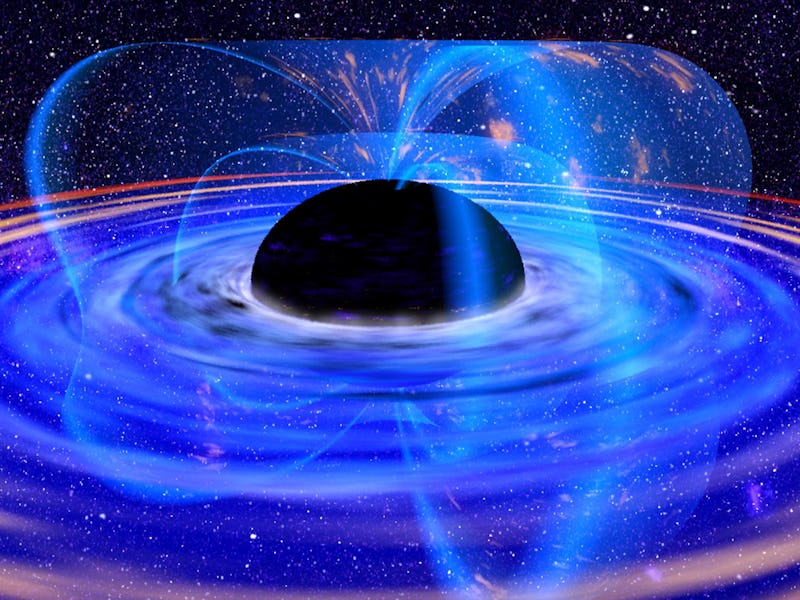The Oldest Black Hole Ever Discovered Is Surprisingly Big
The James Webb Space Telescope peered 13.4 billion years into the past and found a black hole-sized conundrum.

The oldest supermassive black hole astronomers have ever seen is gorging messily on the heart of its host galaxy, which may ultimately doom the black hole along with its prey.
In the process, this ancient black hole — or at least as it looked 13.4 billion years ago — may offer important clues about how the universe’s first supermassive black holes formed and grew. University of Cambridge astrophysicist Roberto Maiolino and his colleagues recently used the James Webb Space Telescope (JWST) instruments to peer into the blazing heart of the black hole’s host galaxy, GN-z11, and watch its voracious feast. They published their work in the journal Nature.
This artisti’s concept shows what a black hole might look like if we could see the lines of its magnetic field.
Big for Its Age
The light we see from tiny galaxy GN-z11 began its journey to Earth when the universe was just 400 million years old, which makes the supermassive black hole in the galaxy’s center the oldest one astronomers have ever seen. Based on recent observations as part of the JWST Advanced Deep Extragalactic Survey (JADES), Maiolino and his colleagues say this ancient supermassive black hole is several million times more massive than our Sun. That massive bulk puts it roughly in the same ballpark as Sagittarius A*, the supermassive black hole at the heart of our own thoroughly modern Milky Way Galaxy.
The black hole’s size also comes as a supermassive surprise since many astrophysicists expected the universe’s first generation of supermassive black holes to take at least one billion years to grow so large.
In their recent paper, Maiolino and his colleagues say there are essentially two ways this black hole could have grown so large, so quickly. The first option is that it was "born" already tens of thousands of times more massive than our Sun when a gargantuan cloud of gas collapsed under its own gravity to form the enormous "seed" of a supermassive black hole. Starting from such large seeds, those original black holes would have needed less time to grow to millions of times our Sun’s mass.
The second option is that the first black holes, including the one at the heart of GN-z11, formed when the first generation of massive stars burned up their fuel and collapsed, leaving behind black holes dozens of times the mass of our Sun. Those (relatively) tiny black hole “seeds” would have needed about a billion years to swallow up enough gas to grow to supermassive size — unless they were eating a lot faster than astrophysicists expected.
And according to Maiolino, the supermassive black hole feasting on the heart of GN-z11 seems to be doing exactly that.
Eat Your Heart Out
The Herschel Space Observatory has shown that galaxies with the most powerful, active, supermassive black holes at their cores produce fewer stars than galaxies with less active black holes. This artist’s concept shows material being ejected from a galaxy by its supermassive black hole.
GN-z11’s supermassive black hole is feeding at an absolutely unhinged rate. Maiolino says if this champion eater could keep it up for just 100,000 years, then it’s totally possible for this beast to have started out as the remains of a dead star when the universe was just a couple of hundred million years old.
That’s a point in favor of the idea that supermassive black holes could once have formed from “seeds” of the mass of large stars, but it doesn’t settle the debate. Another recent study lent support to the idea that black holes may have formed from larger seeds, already thousands of times the mass of a star like our Sun. The only way to know for sure is to peer farther back in time and space and find even older supermassive black holes to help recreate the story of their evolution. What’s not clear is how long the black hole in GN-z11 could keep up this unquenchable appetite because, in the process, it’s ripping the galaxy’s heart to shreds.
Black holes are famously known for being extremely messy eaters. As material spirals faster and faster toward the black hole, it releases energy that lights up the center of the galaxy with a brilliant glow but also shoves nearby gas violently away. The faster a black hole eats, the brighter the disk of material around it glows and the more “food” it throws away.
Because the supermassive black hole at the heart of GN-z11 is feasting so quickly and so messily, it could end up cutting itself off. This could eventually deprive its host galaxy of the gas to make new stars, dooming it to slowly fade into darkness — but not before JWST and subsequent generations of space telescopes learn all of its 13.4 billion-year-old secrets.